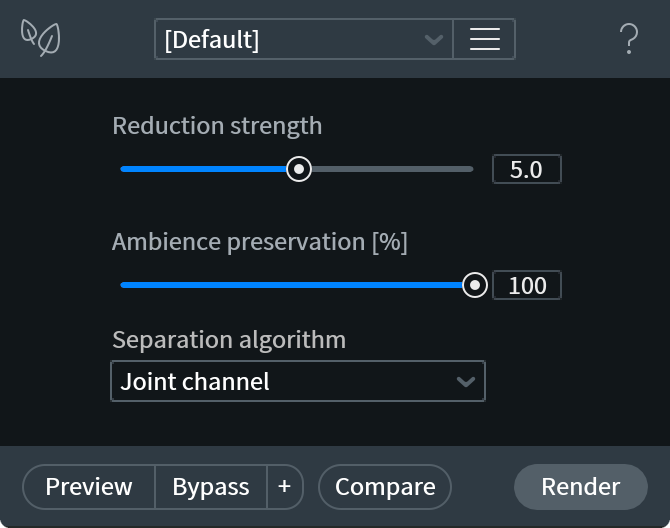De-rustle [ADV]
| Module & Plug-in (Audiosuite Only) |
|---|
Overview
De-rustle is designed to reduce the noise or “rustle” that is often the result of a lavalier microphone rubbing or brushing against clothing during a recording. This type of noise can vary unpredictably over time and exhibit a wide variety of sonic characteristics from higher frequency “brushing” to lower frequency “thuds,” making it a challenging issue to resolve.
The De-rustle module uses a machine learning algorithm trained on isolated rustle samples, clean dialogue samples and dialogue samples with rustle. When processing, De-rustle leverages the trained data to identify and separate the rustle from the dialogue.
Controls

Reduction Strength
Adjusts how sensitive the separation algorithm is to identifying dialogue in the input signal.
- Lower values allow for broader detection of dialogue in the input signal. This can result in more rustle in the processed signal, but can increase clarity of dialogue in the processed output signal.
- Higher values allow for stricter detection of dialogue in the input signal. This can result in more significant reduction of rustle or lav noise, but can decrease the clarity of dialogue in the processed output signal.
Ambience Preservation
Adjusts the amount of background noise to retain in the processed output. The separation algorithm may include background noise and ambience in the signal it has detected as rustle. This can result in unwanted reduction of unrelated background noise in the processed signal.
- Lower values allow for broader detection and separation of rustle against other background noise in the input signal. This can result in more background noise being included and reduced with the separated rustle component.
- Higher values allow for stricter detection and separation of rustle against other background noise in the input signal. This can result in less background noise being included and reduced with the separated rustle component.
Separation Algorithm
The following separation algorithm modes are available in the De-rustle module.
Channel Independent
When this mode is selected, the separation algorithm is applied to the input audio channels independently. Channel independent mode is the fastest Separation algorithm option. It offers the most efficient real-time preview performance and processing speeds when working with the De-rustle module in the RX Audio Editor.
Joint Channel
When this mode is selected, joint channel processing is applied to the input audio before determining the separation between dialogue and rustle signal components. Joint Channel mode offers higher quality separation results than Channel Independent mode, especially when processing stereo files with similar content on both channels (correlated signals, strong stereo image).
Advanced Joint Channel
When this mode is selected, joint channel and additional advanced processing is applied to the input audio before determining separation between dialogue and rustle. Advanced Joint Channel mode offers the highest quality separation results, especially when processing files with high sampling rates. This mode requires longer processing times than the other two modes. If processing time is a concern, Channel Independent mode can be used as a faster, lower quality alternative.
Preview Functionality
Reduced Quality Preview Mode
Unlike many of the modules with preview capabilities in the RX 7 Audio Editor, the De-rustle module utilizes a reduced quality preview mode. Learn more about Reduced Quality Preview Mode.
No Preview in Audiosuite
The RX 7 De-rustle Audiosuite plug-in does not include the ability to preview processing before rendering.